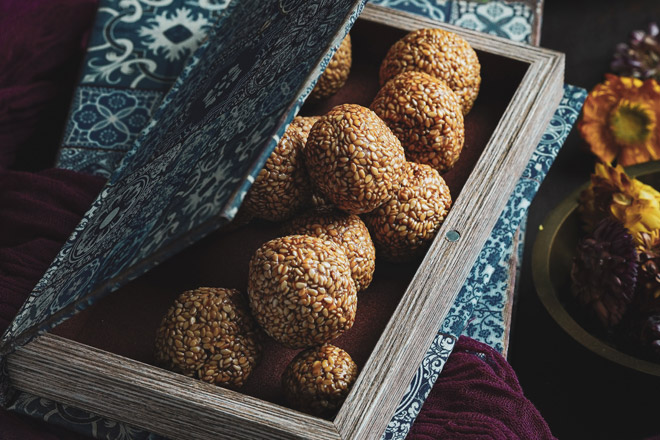The moment we hear the word ‘festival’, our mouths start watering – #YummyFoodAlert! You can almost smell all those festive special lip-smacking goodies! The world over, food is at the heart of any celebration and families get started on the preparations months before the special day arrives.
Here in India, every festival goes hand in hand with specific foods that are reflective of the season and its natural produce. However, these traditional recipes that our grandmoms were master chefs of, are nothing like today’s commercially available saturated fat laden sweets and savouries. I believe that our ancestors crafted seasonal festive recipes for a reason. And it’s sad to note that some of these nutrition-packed age-old food traditions are being washed away by mass production or so-called ‘fusion cooking’ that has led to factory packed son papdis that last a year, or gulab jamun cakes!
Even if some food traditions have managed to survive, we do not know their significance. This blog tries to surmise the reasons behind some of these food traditions and explores their nutritional significance.
Down South
Folks from Tamil Nadu or those with friends from the state might be familiar with Diwali legiyam – a concoction of powders of dry ginger, coriander seeds, cumin seeds, peppercorns, long pepper, caraway seeds and other spices. This is cooked in a jaggery base and portioned into small soft round balls. Grandmoms insisted that one ball be popped into the mouth on an empty stomach first thing Diwali morning. Its mission? To help digest all the sweets and savouries that we’d be filling up on during the day. It also goes by the name Diwali marundu which translates to Diwali Medicine. Most of these spices are now being recognised in modern medicine for their ability to correct gut or digestive disorders. But granny knew best much before!
Let’s now travel to Andhra Pradesh and Karnataka and talk about Ugadi pachadi or Bella bevu that is made on the occasion of Ugadi or Gudi Padwa in April. This liquid concoction features neem leaves, jaggery, tamarind, raw mango, green chillies and salt – beautifully and poetically to symbolise that life is a mixture of sadness, happiness, anger, fear, disgust and surprise. This food tradition activates the taste buds by triggering the palate for bitterness, sweetness, spice, salt, astringency and sourness. Modern science now explains that the stimulation of taste buds is an important process by which our body understands how to handle the nutrients that we get from food and also helps it distinguish between foods and toxins.
Up North
Festive food and jaggery go hand in hand. Being traditional and native to India, different kinds of jaggery from palm, coconut and sugarcane are used to sweeten the moment. Palm jaggery reportedly helps build immunity, protects against a cold and cough, relieves constipation and has more nutrients like vitamins and minerals as compared to white sugar. Grandmoms hold on to the belief that palm jaggery provides ‘heat’ to the body. And that explains why in Bengal, the use of palm jaggery kicks in at the onset of winter just after Durga Puja. Nadu, a ball made up of palm jaggery, coconut and spices is often made on Lakshmi Puja. Palm jaggery then continues to be used through the winter until Sankranti, featuring in sandesh, rosogollas and other Bengali sweets. Sankranti, celebrated in January, marks the start of spring and calls for the switch to sugarcane jaggery which grandmoms believe to be cooling in nature.
Sesame seeds and jaggery are the key ingredients in a variety of sweets that are made for Sankranti. Every state has its own variation using these two ingredients such as tilgul, revadi, gajak or the simple til ke laddu. However, what does not change is the essential fatty acids that are present in sesame and the minerals and vitamins present in jaggery – a combination that energizes the body in the cool climate of January. Here’s a quick recipe video for peanut laddu – also a great winter snack combining jaggery and peanuts.
As Holi approaches, many families in the North start making the absolutely fantastic kanji; a fermented cool beverage made of mustard seeds and black carrots. This must-have is now being recognised by modern nutritional science as a drink packed with probiotics and anthocyanins from the black carrots. Anthocyanins are known for their anti-diabetic, anti-obesity and anti-carcinogenic properties. And we don’t need to convince you on the value of gut-friendly probiotics when it comes to immunity.
There are so many other traditional festival foods that still need a thought such as sukhidi from Gujarat and Rajasthan, parupu kanji on fasting days in the South and pinni during Lohri. There might be so many more hidden nutritional jewels in each family cookbook that need to be explored. Do delve into your family history, ask the elders, interpret them and revive them. They shouldn’t be lost in the passage of time….after all #FoodHeals.
Written by:
Dr. Sripriya Venkiteswaran, PhD (Nutritional Sciences), Content Consultant, CICN
References:
What is jaggery, and is it better for you than sugar? Accessed on 4th Jan 2022
An Evolutionary Perspective on Food and Human Taste Accessed on 5th Jan 2022





